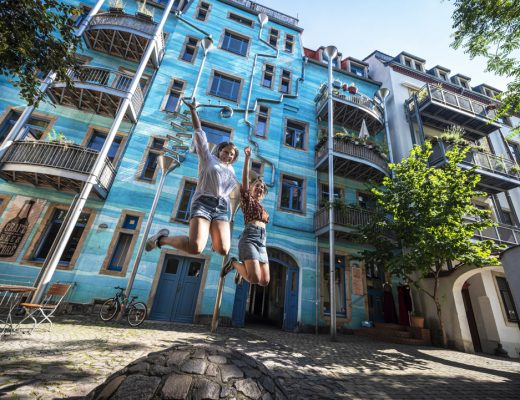Nantes is a lively and peculiar city near the French Atlantic coast. The old town offers everything you’d expect from a classic French city trip, but on top of that its streets and squares are full of quirky public art and home to some very strange creatures. Trot Op! headed south on the TGV and went in for a closer look.

Anyone who regularly browses this blog – and why wouldn’t you, it rocks – might have noticed there aren’t many articles on France to be found on it. Aside from the now two embarrassing losses to the frustratingly dull French national football team, this was of course not done out of malice. Part of the reason is my French being depressingly bad, but more importantly it’s because France has been one of the most popular destinations for Belgians since time immemorial, making it hard for me to still surprise anyone. To convince me to cross the border to La Douce France, you’ll have to lure me in with some truly hidden gems. Nantes might just be one of those: a vibrant city on the banks of the Loire just below Brittany – the so called “nose” of France. It’s a pleasant town and somewhat removed from the standard tourist trail, which makes it much less overrun. This feels a bit strange, because you can easily get here from Brussels by train, and there are plenty of surprisingly unique things to enjoy.
What to do in Nantes: the 9 wildest sights and attractions
In earlier days, Nantes served as the capital of the Duchy of Brittany. This was of course some time ago, but at least they got a nice castle out of it. The imposing Château des Ducs de Bretagne is a massive fortress and serves as the main focal point of the old town. Today it houses an extensive museum on the history of Nantes and the region. The old town itself is quite charming, with your typical facades, cobbled streets full of bars and restaurants and the occasional pleasant park to gobble down some croissants in. No complaints whatsoever.
“Nantes is a vibrant city on the banks of the Loire, somewhat removed from the standard tourist trail. Strange, because you can easily get there by train from Brussels and there are plenty of surprisingly unique things to enjoy.”
History alone doesn’t quite attract the crowds in these strange times however, and thus Nantes took a completely different approach in recent years. Today it’s an innovative city, using its public space creatively. This is most evident during Le Voyage à Nantes: an annual summer art festival, transforming the entire city into an open-air museum. Various artists brighten up the streets with their creations, many of which become permanent additions to the cityscape. As a result, you’ll see strange constructions popping up on every stroll through Nantes. And the best part is you don’t even have to go and look for them. The city almost literally takes you by the hand.
1. La Ligne Verte: your foolproof guide through Nantes




As far as I know, Nantes is the only city in the world where tourist attractions are completely idiot-proof – at least in terms of getting there. Here, you’ll never have to wonder whether or not you missed anything at all. Just walk out of your hotel until you find a literal green line on the pavement, start following it like a lemming and twenty kilometres later you’ll have seen every worthwhile point of interest in the entire city. Originally, the green line was created to connect the Voyage à Nantes art installations, but the idea was so well-received they eventually dragged a paintbrush through the entire city. This is of course quite handy, and unless you unexpectedly drown yourself in the Loire, you’ll always end back up where you started. I’ll leave you with some nice spots along the line I won’t discuss further in the article (because it’s a blog post, not an encyclopaedia): the medieval Bouffay District; the beautiful Passage Pommeraye (a historic shopping gallery); the LU Tower (quirky little tower on top of a biscuit factory turned cultural space) and the Jardin des Plantes (a grand botanical garden near the train station). Start your visit by checking those off, and then read the rest as you please.
2. Nantes and its strange public art




As said before, the green line initially served to connect all of Nantes’ art installations, and by now there’s quite a few of them. Some are fairly surreal. On Place du Bouffay for example, there’s a statue stepping off its pedestal, and a bit further you’ll find a large playground shaped like a wooden Chinese dragon and a football field with random lines that only looks normal in a huge mirror next to it. Staying overnight in Nantes and don’t need much space? Rent the micro house squeezed five metres above the ground in between two other buildings. On Île de Nantes – a large island in the Loire – you’ll discover even more strange art. Les Anneaux are eighteen rings on the promenade that light up at night. Le Mètre à Ruban is a yellow King Kong-sized tape measure laid out in some courtyard. Air is a building with a metal facade that has birds chirping when you walk underneath it. L’Arbre à Basket is a tree made entirely out of basketball hoops, and my personal favourite On Va Marcher sur la Lune is a playground shaped like the moon’s surface with trampolines in the craters. It’s not the McDonald’s ball pit, that’s for sure.
3. Les Machines de l’Île: ride a mechanical elephant




By far the most famous attraction in Nantes can also be found on the same isle: Les Machines de l’Île and the workshop producing them. These guys create all sorts of monstrous moving steampunk constructions shaped like giant animals. One of them will look very familiar to people from Antwerp especially. This is because Les Machines de l’Île used to be part of Royal de Luxe, and these are the folks who parade similar walking giants to my city every few years. The most iconic of them was the huge elephant passing through somewhere in the mid-2000s. There’s one in Nantes as well – oddly enough not the same one – and you can even take a ride on it at a bone-chilling speed of 1 km/h. Not a fan of elephants? Why not take a ride on the huge carousel instead? It has three levels, was made in honour of Jules Verne (who was born in Nantes) and you can hop on a wide range of creepy sea creatures. The most interesting visit is the workshop itself. It’s housed in a large warehouse, and they’ll guide you past various creations (some of them you can ride as well): from car-sized ants to dinosaur-sized spiders, hummingbirds, caterpillars and even a sloth. Great place to spend an afternoon.
4. Le Jardin Extraordinaire: a man-made jungle in an old quarry



From the western tip of Île de Nantes you can – with the Pass Nantes – take a free Navibus to the other shore. This ferry will bring you back to the mainland, to the west of the city centre. You’ll arrive right in front of the Little Atlantique Brewery: a microbrewery in an old oil press factory where you can grab a bite to eat as well. A short walk from here – follow the green line – you’ll find one of Nantes’ most unique spots. Le Jardin Extraordinaire used to be an abandoned quarry where nothing much happened. Now, it’s a fantastic garden. You can walk along the top of the quarry past several viewpoints and descend hundreds of steel steps down the rock wall to eventually end up in what almost literally feels like a jungle. Dense vegetation, exotic plants and even a 25-metre-high artificial waterfall crashing down into a pond of croaking frogs. Delightful place. The garden was opened just five years ago and is still being expanded.
5. Le Mémorial de l’Abolition de l’Esclavage: a reminder of Nantes’ dark history



On the bank of the Loire lies the most poignant monument in Nantes. You’ll notice the first signs about a hundred metres before actually getting there, when you start seeing plaques with strange names added to the river promenade. There are more than 1800 of them, which is the exact number of slave ships built in Nantes. Until the mid 19th century, the city was home to several rich families involved in the slave trade, building the vessels to sail them to West Africa and eventually to the Americas. More than 550,000 men, women, and children were shipped under appalling conditions, never to return. Beneath the promenade is a concrete corridor, covered in historic quotes on freedom and self-determination. This is a must visit place, and one that will leave you silent. The scale of what happened is almost unreal, but the mosaic of tiles at least gives you an impression of how many people’s lives were ruined by this depraved industry. Some of the ships had cynically cheerful names, which makes everything even more disturbing. People do terrible things to each other and this won’t end anytime soon. All we can do is set a good example for others.
6. Le Château des Ducs de Bretagne and other museums in Nantes



Le Château des Ducs de Bretagne is the main museum in Nantes. In it, you’ll walk through dozens of castle rooms and towers, detailing the history of the city and of Brittany – including a gripping exhibition on the slave trade. There are plenty of other museums to visit in Nantes as well. These are the main ones:
–Musée d’Arts de Nantes: one of France’s great art museums, featuring works by Picasso, Kandinsky, Monet, Courbet and Delacroix. It showcases art from the 13th century to the present.
–Musée Jules Verne: small museum (soon to be renovated) near Le Jardin Extraordinaire. It contains manuscripts, first editions and various strange objects and curiosities from Jules Verne’s fantastic stories.
–Musée Dobrée: art museum in a beautiful 19th-century neo-Romanesque building exhibiting the collection of a wealthy art dealer.
7. A touch of Japan in Nantes

Nantes is home to more than one unique garden – and more than one island as well. The Erdre is another one of the city’s rivers. To the north of the old town it flows around Île de Versailles. This is a small island where in the 1980s, a fairly authentic-looking Japanese garden was created: elegant bridges, bamboo groves, traditional pavilions, winding footpaths and koi fish ponds. It may not be the biggest attraction in Nantes, but it’s a lovely spot to unwind, and you don’t often see a Japanese garden like this outside of the country (except of course in Hasselt, check it out). When I visited, a choir was performing and several families were having a picknick. Perfect place to hop off the green line for a second and enjoy some peace and quiet in the shade of a tree.
8. Estuaire: an art trail between Nantes and Saint-Nazaire




There’s plenty of public art outside of Nantes as well. Along the sixty kilometres between Nantes and the charming coastal town of Saint-Nazaire, an entire art route was established. This art trail is called Estuaire, and anyone travelling from one city to the other will encounter 33 works along the way (some of which we’ve already discussed above). These are spread over both banks of the Loire (with free car ferries available in one or two spots), and there are some remarkable pieces among them. La Maison dans la Loire for instance, is a house that seems to be sinking in the river, and Misconceivable is a melting sailboat (identical to the one in Middelheim Park in Antwerp). Three of the most impressive works are found in and around Saint-Nazaire itself. Le Serpent d’Océan is the steel skeleton of a massive snake slithering from the surf. Le Pied, le Pull-over et le Système Digestif are three huge stone statues on the beach that depict exactly what their names suggest (don’t ask me for the deeper meaning, I forgot). Suite de Triangles on the other hand, is an optical illusion painted over hundreds of metres on several buildings, which only comes together from one exact vantage point.
9. Submarines in Saint-Nazaire: visit the Espadon



The most impressive sight in Saint-Nazaire is one you can’t miss. During WWII, the Germans built a ridiculously large submarine base here – with voluntary and highly motivated workers exclusively of course. It can still be seen in the centre today, towering over everything like some concrete Death Star, but it’s been repurposed for various uses since. In a smaller base across the water – its roof the viewing point for the aforementioned illusion – you can still visit an original submarine. The Espadon did not belong to the Germans, but to the French Navy – who used it from 1960 to 1985. Later it started serving as a museum piece. Armed with an audio guide, you can discover what life was like on board for the approximately 65 sailors manning it. To keep it brief: life was mostly pretty cramped. From the tiny kitchen and toilets to the command posts and sleeping quarters: everything feels extremely claustrophobic. The torpedo room was the most spacious area, which says it all. Still an interesting visit, obviously.
Hotels in Nantes and further information

For all relevant information on Nantes as a destination: visit the official website.
A Pass Nantes is very convenient for everyone planning a visit. You can get one for 24, 48 or 72 hours, or for an entire week. It grants free entry to most attractions and includes public transport.
I stayed at Hotel La Pérouse. This is a rather uniquely designed and furnished venue, centrally located on a major boulevard in the city centre.
I had three lovely dinners in Nantes, all of them very tasty: Meraki, Maison Bagarre and Vacarme.
For all decent restaurant options in Nantes, click here.
Fancy another French trip? Read my blog post on Avignon and the Vaucluse. Want to go somewhere else in Europe? Why not Prague, Ticino, Duisburg, Amsterdam-Noord or Scotland?

































No Comments